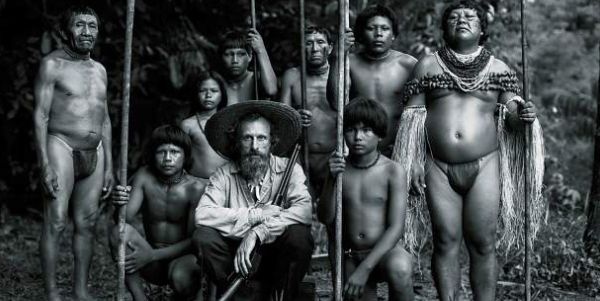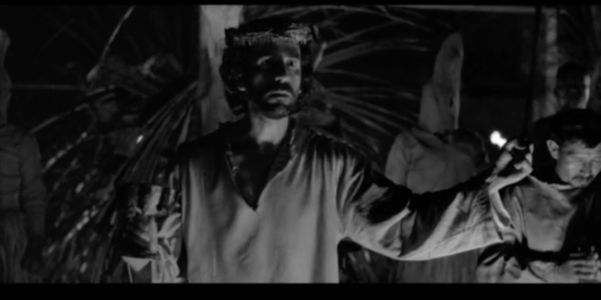EMBRACE OF THE SERPENT: Dark, Expressive, Haunting

Massive film lover. Whether it's classic, contemporary, foreign, domestic, art,…
The most damaging and offensive cliché in films that explore colonialism and its effects on indigenous nations is the notion of the noble savage, as well as the white savior. Approaching this film the inevitable trepidations set in, but were soon quelled, as Embrace of the Serpent proved to be simultaneously intelligent and willfully authentic.
Director Ciro Guerra film adheres to territorial formalism without subverting the cultural atmosphere and originality. The result is something new, accessible, original, and visually astounding.
Two Travelers, Two Stories, One Movie
Guerra tailors a dual narrative recreating the travels of two dissimilar, explorers fixated on the Yakruna plant for its coveted healing abilities. The first journey, taking place in 1909, introduces the fiery-eyed Karamakate, who reluctantly guides ethnologist Theodor Koch-Grünberg (Jan Bijovet) and his companion Manduca (who Theo freed from the rubber plantations) to the Yakruna plant to cure Theo of a life threatening ailment.
Years later, Karamakate finds himself once again acting as an escort, now to Richard Evan Schultes (Brionne Davis), an ethnobotanist, and hallucinogenic cultivator. The trip is the same, but Schultes’ intentions seem less honorable. However, the two press forth upriver, as Karamakate had done once before twenty years ago. While the terrain is familiar, the bending river reveals new challenges, and in some cases these alterations of the past are mutations of colonial influence that were planted twenty years prior.
With Schultes, Karamakate is twenty years older, his fiery temperament seems to have given way to self-imposed amnesia. Spiritually broken, his disconnect with the environment that he once harmonized with epitomizes the universally translatable fate that has befallen the countless nations of indigenous people erased from existence. Based on the journals of both Schultes and Grünberg, the film melds the two timelines in a trance-inducing manner, melding the content into the aesthetic execution.

The two story lines do feature white men, yes, they star in the film, but the real leading character is Karamakate (played by two actors to cover the time span, the young Karamakate played by Nilbio Torres, and the old by Antonio Bolivar). He is a steadfast and unapologetic character defined by his culture.
The first chronological traveler, Theo, acts with good intentions, and his respect towards the native culture is genuine. But his admiration comes at a price, and he loses his patience when someone won’t return his compass. Frustrated not by their desire to keep something of his, he insists it’s a necessity for the journey, and he claims the natives will lose a part of their identity by the advent of the device; he’s reminded that knowledge isn’t limited to the privileged. Instead of the “noble savage” and “white savior”, the self-conscious intonation of change and inversion of stereotypes is refreshing.
Evil Wears a Cross
The expansive territory is imposing, but there’s solace in Karamakate’s ability to communicate and navigate through the Amazon – and there’s no preparation for their encounter with a Christian monastery. The inverted symbolism of recreation and the damaging component of cultural intervention can be interpreted as a crossroads. For instance, in 1909 Karamakate, Manduca, and Theo get rid of an abusive clergyman, liberating native children from captivity. Twenty years later, an even more perverted cult has sprouted in its place. If you cut off a snakes head, it can grow back and carry even more venom.

Ushering us into the heart of darkness the second arrival to the compound, taking a hard right turn into what embodies the horror genre (as if realized by Pasolini, Tarkovsky, or Herzog) as a self-proclaimed deity leads a clan of hooded and deranged disciples. The arid and sickly atmosphere is terrifying, and the collateral damage is a fertile ground for interpretation. The symbolic tracks have been laid down, and there’s more than one way to interpret what’s been given to you in the film.
Horror assumes the spiritual form as well as the literal, realized in scenes presenting the cancerous infestation that was the rubber trade. There are a few point-blank moments almost guaranteed to elicit an emotional response. But Guerra flies a little too close to the sun in some scenes, with some familiar, too on-the-nose tactics. For instance, when Theo and Schultes cling to material possessions that Karamakate urges to throw overboard, or when he points out that money is useless to natives, these are points to obvious to make.
It pains me to see these kinds of clichés arise in Embrace of the Serpent, because I feel like Guerra is too smart a filmmaker for them – though they might be circumstantially justifiable missteps. A minor complaint that doesn’t reduce the content.
Ciro Guerra: Exploration and Art
Ciro Guerra takes on a lot, and he carries the weight successfully thanks to his resonant direction and the naturalistic and effective performances from a (mostly) unrecognizable cast. Embrace of the Serpent occasionally wanders into territories too familiar, but these missteps feel like the result of a director well aware of his the ship he’s steering.

Guerra’s atmospheric realization successfully explores heady topics such as colonialism, genocide, science, mortality, vanity and plenty more of humanities flaws to boot. The most frightening turn is the intervention of Christianity. And the journey, fraught with beautiful and horrific images the result of both man and nature, conveys a sense of dread that might even exceed the horrors of the other films Embrace of the Serpent is so frequently associated with.
Never Get Out of the Boat
While many have associated this film with Apocalypse Now, it bears more resemblance to Herzog’s Aguirre: the Wrath of God. I guess you could say it’s the “other psychologically fraught film about people rafting through the jungle” movie of the 1970’s. One thing that rings true about the Apocalypse Now analogy is the phrase “never get out of the boat”.
This dense yarn is handled with refined style. A very busy and smart film with a meditative slow burn that might haunt you. Embrace of the Serpent is a new entry in an old book.
Are you eager to see Embrace of the Serpent? What do you think of Ciro Guerra’s artful approach to these difficult and ambitious topics?
The film has been nominated for an Academy Award for Best Foreign Film.
Embrace of the Serpent has received a limited release in the U.S. on 17 and 19 February, and for international release dates, please check here.
Does content like this matter to you?
Become a Member and support film journalism. Unlock access to all of Film Inquiry`s great articles. Join a community of like-minded readers who are passionate about cinema - get access to our private members Network, give back to independent filmmakers, and more.
Massive film lover. Whether it's classic, contemporary, foreign, domestic, art, or entertainment; movies of every kind have something to say. And there is something to say about every movie.













